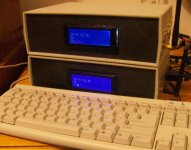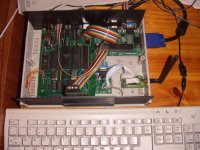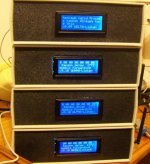Dr_Acula
Experienced Member
I've posted before on the N8VEM project but this development is just too exciting to keep under wraps. The project is now stable enough to go into boxes! Not quite with all the screws done up, but getting close *grin*
See attached photos - this pair of CP/M computers were both just chips and components only two days ago.
Specifications:
Z80 running at 3.68Mhz
Approx 0.25W power consumption
64k working ram
448k battery backed ram disk
16k rom disk containing xmodem and a few other essential files
Socket for uDrive (4dsystems) for 2gig of sd card storage
20x4 LCD display
PockeTerm for driving a VGA display.
Keyboard
2 serial RS232 ports
Yishi wireless module for wireless xmodem file transfers up to 1000 metres
Internet access via Lantronix MSS100 modules
Able to run games, wordstar and multiple programming languages
I'm using these as wireless repeater nodes in a wireless mesh. The concept of a mesh is quite simple - flick a switch on a board anywhere in wireless contact with at least one node, and somewhere on another node a relay closes. Or, sample a voltage 0-5V on a board and somewhere else a voltage 0-5V is available. Behind the scenes is about 500 lines of Basic code on each node, plus all the Assembly and other code needed to run the N8VEM. In my case the mesh is a series of fixed solar powered repeaters and the data is water tank levels and pumps being turned on and off, but it could equally be a group of mobile robots communicating within a house or other applications.
Next step - build some more! The only snag is that these boxes don't look very vintage. Anyone know how to speed up that yellowing process?!
See attached photos - this pair of CP/M computers were both just chips and components only two days ago.
Specifications:
Z80 running at 3.68Mhz
Approx 0.25W power consumption
64k working ram
448k battery backed ram disk
16k rom disk containing xmodem and a few other essential files
Socket for uDrive (4dsystems) for 2gig of sd card storage
20x4 LCD display
PockeTerm for driving a VGA display.
Keyboard
2 serial RS232 ports
Yishi wireless module for wireless xmodem file transfers up to 1000 metres
Internet access via Lantronix MSS100 modules
Able to run games, wordstar and multiple programming languages
I'm using these as wireless repeater nodes in a wireless mesh. The concept of a mesh is quite simple - flick a switch on a board anywhere in wireless contact with at least one node, and somewhere on another node a relay closes. Or, sample a voltage 0-5V on a board and somewhere else a voltage 0-5V is available. Behind the scenes is about 500 lines of Basic code on each node, plus all the Assembly and other code needed to run the N8VEM. In my case the mesh is a series of fixed solar powered repeaters and the data is water tank levels and pumps being turned on and off, but it could equally be a group of mobile robots communicating within a house or other applications.
Next step - build some more! The only snag is that these boxes don't look very vintage. Anyone know how to speed up that yellowing process?!
Attachments
Last edited:



